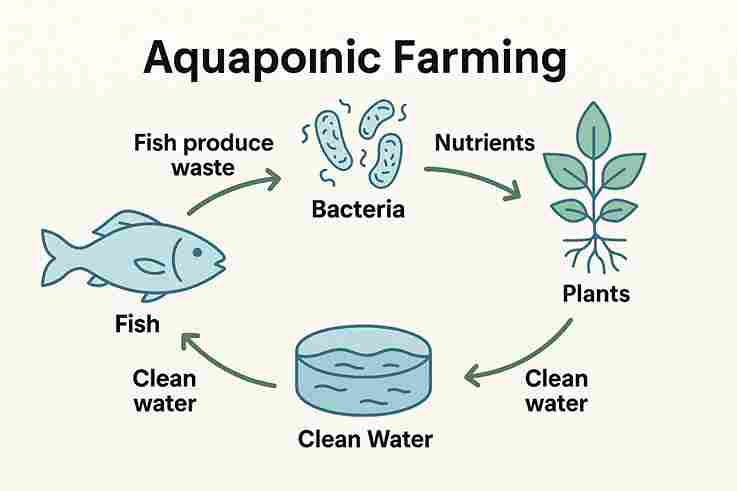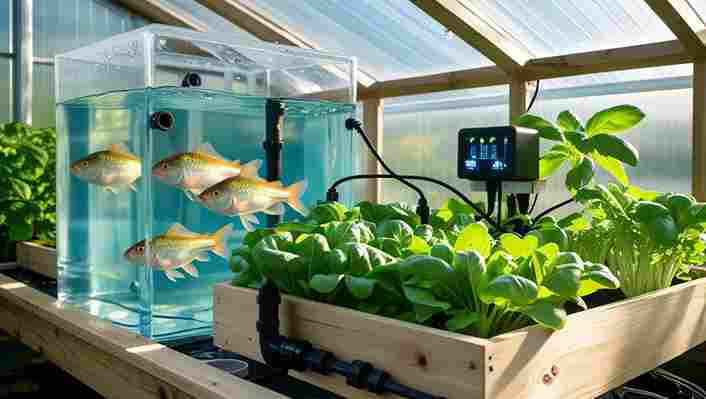Aquaponic Farming : Everything You Need to Know
Aquaponic Farming is a smart, sustainable way to grow food by combining fish and plants in a single water-based system. In simple terms, fish produce waste, beneficial bacteria convert that waste into nutrients, and plants use those nutrients to grow—while cleaning the water for the fish.
Why is it gaining popularity? With water scarcity, soil loss, and rising food prices, Americans are turning to Aquaponic Farming as an eco-friendly solution. It works in small spaces, needs no chemical fertilizer, and uses far less water than traditional farming—making it ideal for homes, schools, and urban areas.
Aquaponic Farming Explained

Here’s how it works:
Fish produce waste → bacteria convert waste to nutrients → plants absorb nutrients → plants clean the water → clean water returns to fish.
This cycle creates a balanced, efficient environment. Fish like tilapia or catfish thrive in tanks. Their waste is pumped to a grow bed, where natural bacteria break it down. The plants use these nutrients to grow, filtering the water before it returns to the fish tank.
No chemical fertilizers are needed. No soil is used. Just a natural loop powered by biology.
Key Parts of a Basic Aquaponic System
1. Fish Tank (The Engine of Aquaponic Farming)
The fish tank is the heart of any aquaponic farming system. It’s where the aquatic life—usually freshwater fish—live, eat, and excrete waste. This waste becomes the raw nutrient source for plants.
As fish metabolize their food, they release ammonia-rich waste into the water. On its own, ammonia is toxic to both fish and plants. But in an aquaponic system, this waste doesn’t go to waste. Instead, it begins a powerful natural cycle. The fish tank water, now rich in ammonia, is pumped out and passed through a biofilter where helpful bacteria convert it into plant-friendly nutrients.
Tank size depends on your scale. A small home system might use a 50-gallon tank, while commercial operations may need thousands of gallons. The key is balance: healthy, well-fed fish produce enough nutrients to support the plants without overwhelming the system.
Choosing the right fish matters, too. Hardy, easy-to-care-for species like tilapia, goldfish, or catfish are common in beginner setups. They tolerate a range of temperatures and water conditions, making them ideal for new growers.
Proper oxygenation and water quality are essential. Use aerators or air stones to keep fish healthy. Regular water tests help you track ammonia, nitrite, and pH levels—all critical for success.
In short, the fish tank is more than just a container—it’s the biological engine that fuels the entire aquaponic ecosystem.
2. Grow Bed (The Green Zone of Aquaponic Farming)
The grow bed is where your plants grow, thrive, and filter the water. It sits above or beside the fish tank and is filled with a soilless growing medium—commonly expanded clay pebbles, lava rocks, or other inert materials that support plant roots while allowing water flow.
As nutrient-rich water from the fish tank is pumped into the grow bed, plant roots absorb the nitrates and other minerals created by the bacteria’s conversion of fish waste. This turns the grow bed into a powerful natural filter, cleaning the water before it returns to the fish.
Clay pebbles are popular because they’re lightweight, pH-neutral, and provide excellent aeration. They give roots room to breathe while allowing for strong water drainage, which prevents rot.
The grow bed is often designed as a flood-and-drain system (also called ebb and flow). Water flows in to submerge the roots and then drains away, giving plants a balance of nutrients and oxygen. This cycle supports rapid growth and healthy plants.
You can grow a variety of crops here, including leafy greens, herbs, tomatoes, and even strawberries. The key is matching the plant selection with the nutrient output of your fish and the size of your system.
In short, the grow bed is the plant’s playground—but it’s also a filtration system and nutrient processor. Without soil, plants grow cleaner, faster, and in harmony with aquatic life.
.3. Water Pump & Filter
The water pump and filtration setup are the backbone of any aquaponic farming system. They keep water moving, clean, and oxygen-rich—ensuring both fish and plants stay healthy.
The water pump draws water from the fish tank and sends it to the grow bed. This constant movement ensures that nutrient-rich water reaches the plant roots regularly. In small-scale systems, submersible pumps are common and easy to install. Larger setups may use external pumps for higher flow rates.
Before the water reaches the plants, it passes through a filtering stage. This usually includes:
- Mechanical filtration to trap solid fish waste and uneaten food.
- Biofiltration, where beneficial bacteria break down ammonia and nitrites into usable nitrates.
These filters protect the plants from clogging and maintain water clarity. Some systems use a swirl or radial flow filter to separate solids. Others may combine sponge filters or gravel beds with a biofilter zone.
A good filtration system ensures:
- Clean, oxygenated water for fish
- Nutrient-rich, debris-free water for plants
- A balanced ecosystem with minimal maintenance
In essence, the pump and filter work together to cycle life through the system—powering the water loop that makes aquaponic farming possible.
4. Bacteria Colony
At the heart of aquaponic farming lies a vital, invisible component: the bacteria colony. These beneficial bacteria serve as the natural link between fish and plants, turning waste into nourishment.
Here’s how they work:
- Fish release ammonia through their waste.
- Nitrosomonas bacteria convert ammonia into nitrites—a form toxic to fish.
- Nitrobacter bacteria then transform nitrites into nitrates, a plant-friendly nutrient.
This biological process is known as nitrification.
The bacteria typically live on surfaces with good water flow—especially in the grow bed media (like clay pebbles) and biofilters. They’re not harmful; in fact, they are essential. Without them, toxic ammonia would build up and endanger the fish, while the plants wouldn’t receive usable nutrients.
Key facts:
- A stable bacteria colony takes 3–6 weeks to establish when starting a new system.
- These bacteria thrive in water temperatures between 65°F–85°F (18°C–29°C).
- pH levels should stay between 6.8–7.2 for optimal conversion and plant uptake.
This natural cycle makes aquaponic farming both sustainable and low-maintenance, with minimal added fertilizers or chemicals.
Benefits of Aquaponic Farming
Aquaponic Farming uses far fewer resources than traditional growing methods. It’s clean, efficient, and adaptable for today’s world.
Saves water efficiently
Aquaponic farming uses up to 90% less water than traditional soil-based agriculture. That’s because the system recirculates water in a closed loop. Instead of water draining away, it cycles from the fish tank to the grow bed and back again. Plants take up only what they need, and evaporation is minimal. This makes aquaponics an ideal option for drought-prone regions or water-conscious growers.
Fits into compact spaces
Aquaponic setups are perfect for small urban areas. Whether you live in a city apartment, have a rooftop, or manage a school greenhouse, you can grow food efficiently. You don’t need wide-open farmland. Vertical grow beds or stacked systems make the most of tight quarters. This flexibility helps bring food production closer to where people live—reducing food miles and promoting self-reliance.
Requires no chemical fertilizers
One of the biggest benefits of aquaponic farming is its natural nutrient cycle. Fish waste provides the nutrients that plants need to grow. There’s no need for synthetic fertilizers or additives. Beneficial bacteria convert the waste into plant-ready forms of nitrogen. That means fewer inputs, no chemical runoff, and a cleaner final product. It’s a win-win for people and the environment.
This method works well in homes, schools, and cities. It’s a smart, sustainable way to grow food in a changing climate.
U.S. Climate Considerations
Cold regions: Keep it warm and indoors
In northern U.S. states, winter temperatures can drop well below freezing. For aquaponic farming to work year-round, an indoor system is essential. Set it up in a heated basement, garage, or greenhouse. Use aquarium heaters or water-safe immersion heaters to keep the tank between 68–75°F. Insulate tanks and pipes to prevent heat loss. Choose cold-tolerant fish like trout if you’re running an unheated setup seasonally.
Hot, dry states: Watch for water loss
In states like Arizona, Nevada, or West Texas, extreme heat and dry air can cause rapid evaporation. This reduces water efficiency. Shade your system to avoid direct sun exposure. Use a tight-fitting lid on the fish tank. Consider evaporative cooling or burying tanks partly underground. Regularly top off water levels to keep the system balanced.
Humid regions: Control moisture buildup
In the Southeast—think Florida, Louisiana, or coastal Carolinas—high humidity can lead to mold, algae, or root rot. Ensure excellent airflow using fans or passive vents. Use light-blocking covers to reduce algae growth in tanks and grow beds. Opt for moisture-tolerant plants like basil, mint, or leafy greens. Keep filters and plumbing clean to avoid bacteria overgrowth.
Tip for beginners
Start small and indoors if your local climate is extreme. Observe how your system reacts across seasons. Then scale up or modify based on what works best in your region.
Getting Started with Aquaponic Farming
Starting small is the smartest move. Aquaponic farming works well even in tight spaces like apartments or condos. You don’t need a backyard or a greenhouse.
1. Start small
Choose a tabletop or vertical system. A 10–20 gallon fish tank is enough to grow herbs or lettuce. Place it near a sunny window or use grow lights. Apartment balconies also work well with proper shading.
2. Test water often
Healthy water means healthy plants and fish. Use a basic water test kit to monitor pH, ammonia, nitrites, and nitrates. For beginners, aim for a neutral pH (around 7.0). Test weekly and adjust gradually if needed.
3. Use hardy plants
Start with leafy greens like lettuce, spinach, or kale. Herbs like basil and mint also thrive. These plants grow fast and are forgiving if your water balance isn’t perfect. Avoid fruiting plants until you gain confidence.
Apartment-friendly tips:
- Choose compact fish like guppies or goldfish.
- Use a siphon drain system to reduce noise.
- Avoid overfeeding fish to control smell.
- Place a waterproof mat under the unit to prevent water damage.
Aquaponic farming is surprisingly flexible. With a little care and consistency, even a corner of your kitchen can become a mini farm.
The Future of Aquaponic Farming in America
Aquaponic farming holds real promise for reshaping how America grows food. Its closed-loop system fits perfectly into future-forward solutions for food access, education, and sustainability.
Tackling food deserts
In urban areas where grocery stores are scarce, aquaponic farming offers a way to grow fresh produce locally. Community centers, apartment complexes, and even abandoned buildings can host indoor farms. These setups bring leafy greens and herbs right to neighborhoods in need—cutting transport, spoilage, and cost.
Urban farming at scale
As cities expand, so does the need for hyper-local food. Rooftops, basements, and empty lots are now being turned into productive grow zones using aquaponic systems. These urban farms need less space, less water, and fewer inputs than traditional agriculture. That makes them a smart fit for growing cities.
Community gardens and cooperatives
Shared aquaponic systems can bring people together. Local residents can build and manage these farms collaboratively. In return, they get fresh vegetables, shared skills, and a greater sense of food security. These community gardens also help reconnect people to where their food comes from.
Hands-on science education
Many U.S. schools are now introducing aquaponic farming into their science labs. It’s a perfect way to teach biology, chemistry, and sustainability in one working model. Kids get to raise fish, grow plants, test water, and track growth—all while learning real-world problem-solving.
Aquaponic farming is more than just a method. It’s a movement—one that can shape healthier, greener communities across America.
FAQ: Aquaponic Farming in the U.S.
Final Thoughts
Aquaponic farming is more than a gardening trend—it’s a shift toward sustainable, self-contained food systems that use fewer resources and produce less waste. As American cities expand and climate pressures mount, the need for water-wise, space-saving agriculture is more urgent than ever.
This method brings together fish, plants, and beneficial bacteria in a balanced loop. It conserves up to 90% more water than traditional soil farming. It works beautifully in spaces that would otherwise go unused—like rooftops, basements, or garage corners. And it eliminates the need for chemical fertilizers, thanks to natural fish waste that nourishes crops.
In cold climates, indoor aquaponic setups offer year-round growing potential. In hot or dry areas, water retention strategies help minimize evaporation. Even in humid regions, simple ventilation and system hygiene keep things running smoothly. With thoughtful planning, aquaponics is adaptable to nearly every U.S. climate zone.
More importantly, this farming method has real social potential. It can bring fresh food to underserved neighborhoods, support hands-on science in schools, and build resilient local food networks through shared urban gardens.
Whether you’re a curious beginner or a future community grower, now is the time to explore aquaponic farming.
💬 Have thoughts, questions, or tips of your own?
Share them in the comments—your insight might just help someone get started.

Silvia Heart is a lifestyle and wellness writer with a background in apparel and a degree in fashion. She blends creativity with practical insights, guiding readers toward intentional, balanced living. Through her approachable style and thoughtful storytelling, Silvia inspires her community to embrace both everyday joy and personal growth.


